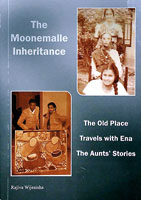Endless and diverse personalities jump out of the page
View(s):Book facts: The Moonmalle Inheritance by Rajiva Wijesinha. Reviewed by Anthea Senaratne
This highly personalised account of the author’s adventures first as a child and then as an adult, is filled with details of experiences and encounters with his family members and friends. It is almost like falling down the rabbit hole like Alice did and landing in Wonderland where escapades are endless and diverse personalities pack the stage!

The book is a dedication to the famous Sri Lankan entrepreneur, Ena de Silva, who is renowned in the field of local arts and crafts and for the opportunities she gave the local people of the villages to display their artistic talents. Also the book brings out the charismatic character of Ena describing her daring ideas and unconventional lifestyle. The author’s descriptions of Ena are not only enlightening and entertaining , but sometimes quite hilarious!
The character of Ena is well established through all the travelling and getting together with relatives in what seems a never-ending session of lunches and dinners – most of them being the culinary blessings of Ena herself.
The book is divided into three parts, the first being a whirlpool of descriptions of the author’s visits to the ‘Old Place’ in Kurunegala, a walauwa owned by his grandmother’s ancestors, where he spent many happy times with his aunt and enjoyed holidays that were totally immersed in the culture of that period. This mansion was built by Edward Gregory Gunawardena, an enterprising young lawyer from Galle, in the late 19th century. Family connections which include the Moonemalles, Hulugalles, Wickremesinghes and Wijesinhas play a major role in the lives of those mentioned in the book. It was a time when families were large, houses were large with sprawling gardens bursting with trees. This carefree atmosphere gave children the delightful opportunity of roaming freely and merging with the natural surroundings of the area.The characters who are all real-life persons never cease to intrigue and sometimes even surprise the reader.
Rajiva also relates his extensive travels abroad not only for his studies but also because he enjoyed seeing new places and cultures giving the reader an interesting insight as he moves through many different parts of the world.
The second part of the book is entitled ‘Travels with Ena’ and here the author gives vivid and interesting accounts of his trips with his aunt and various other friends who join them from time to time. Here again the absolute abandon with which the travellers move through their journeys to so many parts of the Island gives a candid picture of what it was to travel with people like Ena and her large and varied entourage of friends and relatives. From the jungles of Wilpattu, Yala and Horton Plains to the cool climes of Nuwara Eliya (or Nureliya as they pronounced it!) to the sacred cities of Anuradhapura and Sigiriya to the east coast of Trincomalee, they journey through times of peace and then turmoil with the JVP uprising and the dangers brought on to society by their acts of terror.
Part Three contains stories from his books – ‘When the Lamp was Shattered’, ‘A Twitch of the Thread’ and ‘Degeneration’ from his book ‘The Servants’ which won the Gratiaen prize in 1995. Then there is an excerpt from ‘Acts of Faith’ and another from ‘Days of Despair’. Although these stories and excerpts are classified as ‘fiction’ there is a strong element of fact intertwined in them, so that they are more ‘faction’ than fiction! Society with its undercurrents of deviousness and immorality pasted against the prim and proper outer coating is described vividly. The stories ‘A Twitch of the Thread’ and‘Degeneration’ are examples of this.
Some characters mentioned in this part of the book too can be recognised as ‘real’ persons and there may be many readers who could easily identify them. The inclusion of real names however can lead to displeasure and disapproval to those readers who are connected in one way or another with such characters and this is where writers have to tread carefully, because even if characters mentioned are no longer alive there are bound to be relatives around who will naturally take objection to such references. But author Rajiva has nonchalantly taken this risk!
Rajiva writes about all these people in a very down-to-earth manner. We read about the nuances and intricacies of society at that time and the delicate if sometimes impossible balance among the characters and situations in his stories. They portray the cultural norms and beliefs of the time in which class and caste played a vital role. The references to the JVP uprising and the threat of further terrorism bring back memories of the traumatic experiences all of us experienced in some way or another.
The author in writing about his childhood and boyhood days captures with deep nostalgia a lifestyle and an era that will never return.
Follow @timesonlinelk
comments powered by Disqus


